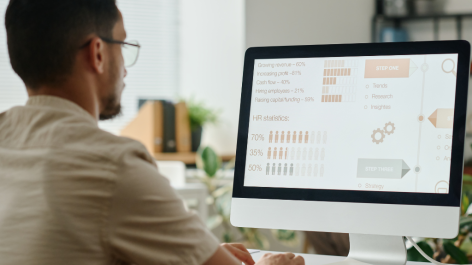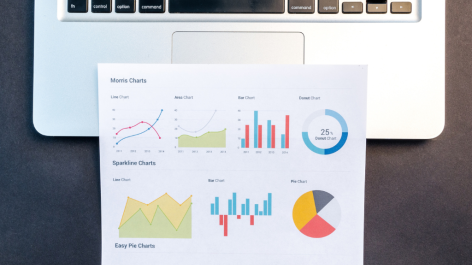You’ve reviewed this quarter's resource utilisation and noticed your team has spare capacity for additional tasks. Your overall capacity stands at 75% and there’s a queue of new client requests ready to be allocated.
There’s only one problem.
You’ve been so preoccupied with overall capacity that you’ve forgotten a critical part of the equation. The individual team members.
While your team may collectively have free time, this doesn’t mean every individual has billable capacity. Some team members might be nearing their (billable and unbillable) limits—risking burnout. While others have ample billable time, but tasks aren’t aligned to individual skills and aspirations.
Effective resource utilisation is more than just filling schedules; it's about assigning work that's both meaningful and suited to your team's skills and aspirations. This approach ensures you meet client demands while keeping your team content, skilled, and flourishing in their roles.
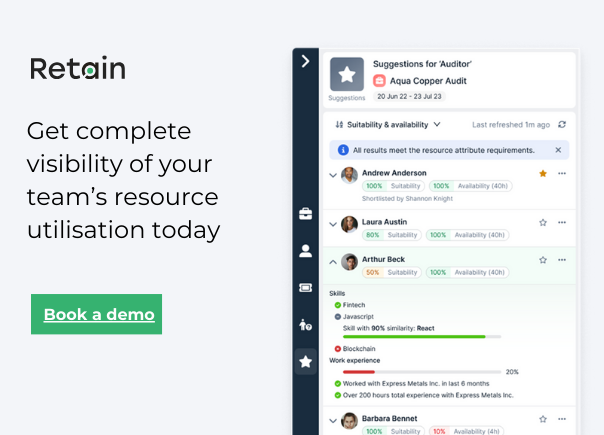
Resource utilisation: A quick refresher
Quick refresher: resource utilisation is the process of understanding how much of your available resources are used, including both billable work and non-billable time. When done well, it can help you to plan how to utilise your resources better, while ensuring employee and client satisfaction.
But, for firms in the professional services sector, there's an added layer to consider.
It's not about aiming for the highest utilisation percentage. It’s about a balanced and nuanced approach, that allows you the flexibility to pivot to unexpected changes, while supporting your team's wellbeing.
Resource Management expert, Rahat Ahmed, from Retain, says it best; “Organisations have finite resources. High utilisation is often prized. But when variances occur, there is typically insufficient resources (time, money, people, etc) to react and recover. Failure is then inevitable, as are the consequences for people.”
How do you implement best practice resource utilisation? It starts with the basics.
Understanding resource utilisation: the basics
Resource utilisation is about understanding how your team spends their time and aligning this with your business goals. Calculating resource utilisation involves looking at both billable and non-billable activities, offering insights into how team efforts contribute to your business's success.
Here’s how to calculate overall utilisation and billable utilisation:
Overall utilisation
Overall resource utilisation takes into account the full range of activities your team engages in. This includes billable client work, as well as non-billable yet essential tasks like internal projects, attending training sessions, participating in workshops, and going to conferences.
It's all about the percentage of time your team is actively contributing to the business's goals, both directly and indirectly.
For example, imagine an accounting firm. Their overall resource utilisation might show that 50% of the time is spent on client consultancy (billable), 30% on developing new internal processes (non-billable), and 20% on skill development and team-building exercises (non-billable). The formula to calculate this is:
(total registered hours / total hours available) x 100
Billable utilisation
Billable utilisation hones in on the time spent on tasks that generate revenue. This metric is critical in showing how your resources are not just productive, but also contributing directly to your business's financial health.
Take, for instance, a software development firm. If their developers spend 70% of their time coding for client projects (billable) and the rest on internal projects and training (non-billable), the billable utilisation will be calculated using:
(Total registered billable hours / total hours available) x 100)
Side note: Retain makes this incredibly easy to do. You can measure billable and non-billable resource utilisation both on a group and individual level, and filter by timeframes, divisions, teams, individuals, and more. You can take a look here if you want to check it out.
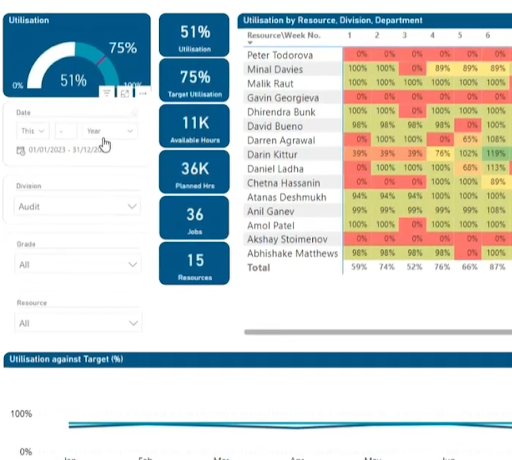
(Retain provides tools, charts, and reports to measure billable and non-billable resource utilisation both on a group and individual level.)
Optimising resource utilisation: a balanced approach
Once you have grasped the basics of calculating resource utilisation, the next step is to determine optimal resource utilisation. This is a nuanced task. While a 100% (or even 90%) utilisation rate might seem like the ultimate goal, it's neither feasible nor beneficial in the long run.
Why? Because non-billable hours are essential for completing tasks effectively, and team members require downtime to prevent burnout and maintain peak performance.
So, what's a realistic target for resource utilisation?
For overall resource utilisation, a healthy range is between 80-100%. This figure is derived using the above formula; (total registered hours / total hours available) x 100.
But when it comes to billable utilisation—focusing solely on project-related work—the sweet spot lies around 70-80%. This accounts for the unavoidable administrative tasks and other non-project-related duties.
Rahat echoes this sentiment. “We often see the most optimal resource utilisation when clients set utilisation targets for all project resources at or below 80%. This approach not only avoids inefficiency but also prevents the costly delays, errors, and employee well-being issues that can occur when resources are overutilised.”
Here’s a scenario to illustrate what we mean.
Optimal resource utilisation example
Consider the case of an IT consultancy firm. They had long prioritised a high utilisation rate of 90%, aiming to keep their staff engaged in client projects as much as possible. However, they noticed a pattern of recurring burnout and a decline in project quality. Realising the need for change, they conducted an internal review and decided to recalibrate their utilisation targets.
They set their overall resource utilisation target at 85% and billable utilisation at 75%. This change meant that their consultants now had more time for professional development, internal projects, and crucial downtime.
Over six months, this approach led to improved staff well-being, higher quality of work, and increased client satisfaction. It was a shift from quantity to quality, focusing on value rather than just volume.
Bottom line: While a high resource utilisation rate is often seen as a marker of efficiency, it's crucial to balance this with the quality of work and the well-being of your team. This balanced approach not only enhances the work environment but can also lead to increased profitability and client satisfaction.
Resource utilisation pitfalls
As illustrated in the above example, when assessing your business's resource utilisation rates, it's crucial to steer clear of two common traps.
❌The first trap is setting overly ambitious utilisation targets. While maximising productive utilisation might seem economically sound, it's unrealistic and often counterproductive to expect resources to be fully engaged at all times. The ideal scenario is one where your teams are busy but not burdened. Overloading them leads to stress and reduced efficiency. Remember this balance when planning resource utilisation.
❌The second pitfall involves misinterpreting what resource utilisation data represents. It's vital to understand that these figures are not indicators of individual performance. Instead, use tools which can create resource utilisation reports for forecasting resource demands and guiding hiring decisions. Pay attention to areas where utilisation is consistently higher than anticipated, as this signals a need for additional resources or reallocation.
You might be thinking; “This is all getting a bit complicated”, so let’s break this down into key steps. ?
How to optimise resource utilisation in 3 steps
Resource utilisation, like any crucial business metric, demands consistent tracking, monitoring, and analysis. Here are three core steps for a best practice approach:
1. Consistent tracking: The foundation of measurement
You can't manage what you don't measure. So, begin by collecting data through digital timesheets. Remember, actual working hours often differ from planned ones, making accuracy in timesheets vital. Set up a time-tracking system, categorising activities into client and internal projects, billable and non-billable tasks. For internal work, further break down into categories like training, business development, and internal meetings. Strive for a balance – detailed enough for insights but simple enough to avoid overwhelming your team.
Beyond just tracking hours, consider both past and planned utilisation. For example, if Peter, your Solution Architect, had a 10% billable utilisation in March, compare this with what was planned for him. Combine actuals with planned metrics for a complete picture. Also, factor in costs per employee or contractor and track charge-out rates for billable activities, considering work schedules, leave, and holidays etc.
2. Analysis and optimisation: From data to decisions
Analyse both actual and estimated utilisation, including costs. This analysis, especially when plotted over time, uncovers team availability for new projects. Early identification of bottlenecks, both in projects and personnel, is crucial. Over-utilised resources signal a need for hiring or contracting additional help. And future project planning may require rescheduling, upskilling, or hiring based on resource availability.
Use charts to illustrate team-level resource utilisation and detailed reports for individual team members. Remember, these shouldn't be used as sole performance indicators. Comparing actual utilisation with planned figures helps in understanding project progress and reducing variances. Track billable versus non-billable utilisation; a high billable rate is desirable, but it must align with healthy profits. Low profits despite high billable utilisation warrant a review of costs, charge-out rates, and billing practices.
3. Goal setting: The path to long-term success
Finally, set achievable, realistic goals for resource utilisation. It's a significant indicator of your business's health and should be included in key business metrics. These objectives should focus on generating revenue and improving long-term operational efficiency, keeping stakeholders informed and engaged in the process.
Side note: You may notice a common thread with all the steps above; most of these are easier to achieve through a specific platform. While you can calculate resource allocation using tools like Excel, it’s not the best tool for the job (more on this here).
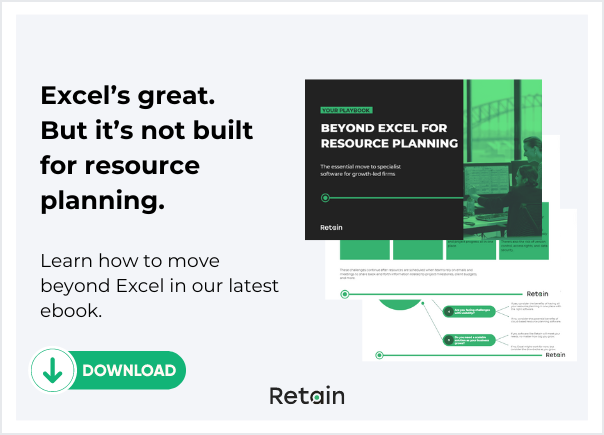
You’ll need a resource planning tool to handle the number crunching.
Using resource utilisation and planning software
As we’ve seen, a major hurdle in achieving effective resource utilisation is gaining complete visibility over all resources available to an organisation. This is where a resource planning tool like Retain, steps in.
Resource planning software offers an added layer of insight, aiding both in the planning of working hours and in reporting on completed projects.
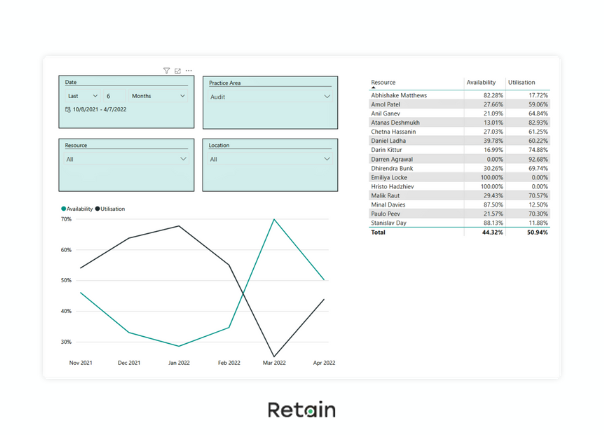
(With our powerful reporting and filtering capabilities, you can easily manage your resources and predicted demand fluctuations in your overall resource utilisation and availability.)
Benefits of a resource utilisation tool
A tool like Retain brings to the table user-friendly resource utilisation charts that easily integrate into your business operations, making planning, tracking, analysis, reporting, and forecasting utilisation more efficient than ever.
It provides nuanced insight into real-time resource availability and utilisation. You can easily filter by date, divisions, teams, individual resources, and more. Plus, red, amber, green (RAG) colour-coding helps quickly flag utilisation rates, so that you know where to dig a little deeper.
Similarly, automated reports eliminate the need for manual resource utilisation calculations. (No more fiddly and error-prone Excel formulas!?).
The integration of resource planning, resource scheduling, skills matching, and timesheets into one unified dashboard simplifies the process for every project manager and team member.
Key takeout: Manually calculating resource utilisation is not only time-consuming but also prone to errors. In a business environment where time is precious and allocation mistakes can lead to costly conflicts and delays, real-time planning insights are invaluable.
Tools like Retain, enable project managers to adapt swiftly to evolving plans and milestones, addressing common resource management challenges such as:
- Shifting project requirements
- New client timelines
- Competing resource demands
- Urgent or unexpected tasks
- Employee burnout
Being able to say a project was completed on time and budget is a huge achievement. But using the right system to hit optimal utilisation rates dramatically increases your chances of doing it.
For more ideas on how to implement best practice resource management, join our LinkedIn community and newsletter.
